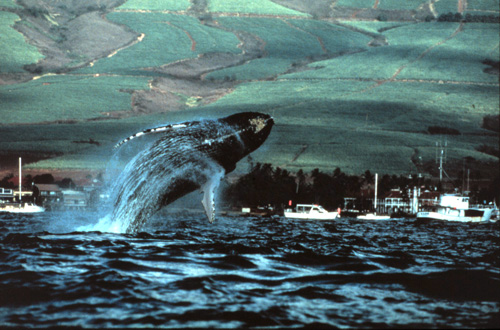U.S. judge limits Navy underwater sonar
to protect whales

Photo courtesy NOAA Fisheries
Service
By Julia Cheever
February 8, 2008
A federal judge in San Francisco has ruled that the U.S. Navy
must stop blasting powerful underwater sound waves in several
areas of the ocean, including one off the Monterey coast, because
whales and other sea creatures could be harmed.
U.S. Magistrate Judge Elizabeth Laporte issued the ruling Wednesday
in a lawsuit in which environmental groups are seeking to limit
the Navy's use of low-frequency sound waves in training and testing
of a program to detect enemy submarines.
The Navy uses the sound waves, which can travel hundreds of miles,
to detect submarines. Conservation groups, including the Natural
Resources Defense Council, the Humane Society and the Ocean Futures
Society, say the intense noise threatens whales, dolphins, sea
turtles and other marine animals.
Laporte wrote, "It is clear that marine mammals, many of
whom depend on sensitive hearing for essential activities like
finding food and mates and avoiding predators, will at a minimum
be harassed by the extremely loud and far-traveling low frequency
active sonar."
Under Laporte's ruling, the Navy will be able to continue using
the sonar for training purposes in much of the world's oceans
and will be able to use it even in the protected areas if there
is an actual danger of a submarine.
But Laporte added new sites to ocean areas that were previously
off-limits for routine exercises. The new areas include the Davidson
Seamount, an underwater former volcano near the Monterey Bay National
Marine Sanctuary; the Galapagos Islands; the Pelagos in the Mediterranean
Sea; the Great Barrier Reef and an area northwest of Hawaii.
Laporte said she will issue a preliminary injunction, but ordered
the environmental groups and the Navy to confer on the terms of
the order and report back to her on Feb. 19.
Joel Reynolds, a lawyer with the Natural Resources Defense Council,
said, "This order protects marine life around the world from
a technology that can affect species on a staggering geographic
scale. But the court also gives the Navy the flexibility it needs
to train effectively."
Navy Pacific Fleet spokesman Mark Matsunaga said the Navy currently
has two ships equipped with the sonar, both operating in the Western
Pacific.
He said the ruling "allows us to continue testing and training
with low-frequency active sonar in the Western Pacific, an area
of great strategic interest, and it allows flexibility for use
in coastal areas."
The ruling is the second time this week that a federal judge
ordered limits on Navy use of sonar.
On Monday, a federal judge in Los Angeles barred the Navy's use
of mid-frequency sonar, a different system, in training exercises
off southern California.
--
Permalink
####
|